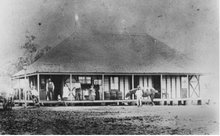
I knew the photo was my grandfather’s Uncle George and that he was an architect. I didn’t know much else about him. I think that my grandfather was an apprentice to him when he was young. We don’t have much contact with that side of the family. No rift or anything particular, just lack of contact. When I proceeded to dig further I was astonished to find a wealth of information about George. In the picture he is standing on one of the columns in front of the Sydney GPO that his firm designed and built. When I used to work in the Sydney CBD, I walked past those pillars everyday on my way down Martin Place from the train station to the office and felt a sense of possession about them.
There were other photos of George in the archive and plenty of material. Apparently George’s company was responsible for a lot of the underground telephone cable tunnels that burrow underneath Sydney. George also supervised the controversial clearing of the Rocks in 1900 after an outbreak of the plague. For this, he received a commemorative shield emblazoned “Victor of the Plague” that is in the collection of the Powerhouse Museum. Theses have been written about his role in the cleansing of the area of the poor mainly immigrants whose homes were squeezed onto the foreshore at the heart of Sydney. Many aspects of what was essentially a slum purge (officially called a “cleansing operation”) were documented by photographs, all of which are in the national archives. The old CSR factory site which is now the expensive foreshore development “Jackson’s Landing” encompasses the street named after George and his brother. There’s another street named after him in Guildford.
George was also a politician. He was mayor of Prospect in 1892 and Member of the Legislative Assembly (representative in state parliament) for Cumberland in 1893/4. He was born in 1859 in Pyrmont (of Glaswegian immigrant parents) and died in 1903 of “gastritis” at the age of 43. It was widely believed at the time that his disease was linked in some way to his work in the Rocks.
There’s a church named after him and the
Interestingly one source says that he ran for office on the basis of female suffrage. My Great-aunt, one of the first female architects to graduate from Sydney Uni, was employed for a short time by his firm in its fairly small Brisbane office. I’ve written about visiting one of the few extant houses that she designed. She gave up architecture for the arts and crafts.
So that’s what happens when you start browsing around in archives. It’s just dangerous.

No comments:
Post a Comment